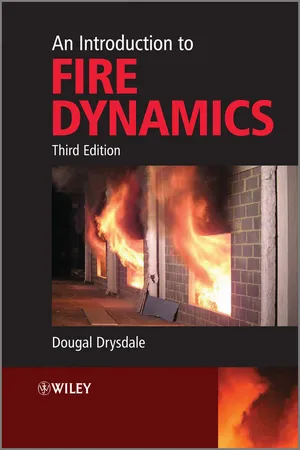![]()
Chapter 1
Fire Science and Combustion
As a process, fire can take many forms, all of which involve chemical reactions between combustible species and oxygen from the air. Properly harnessed, it provides great benefit as a source of power and heat to meet our industrial and domestic needs, but, unchecked, it can cause untold material damage and human suffering. In the United Kingdom alone, direct losses probably exceed £2 billion (2010 prices), while over 400 people die each year in fires. According to the UK Fire Statistics (Department for Communities and Local Government, 2009), there were 443 fatalities in 2007, continuing a downward trend from over 1000 in 1979. In real terms, the direct fire losses may not have increased significantly over the past two decades, but this holding action has been bought by a substantial increase in other associated costs, namely improving the technical capability of the Fire Service and the adoption of more sophisticated fire protection systems.1
Further major advances in combating unwanted fire are unlikely to be achieved simply by continued application of the traditional methods. What is required is a more fundamental approach that can be applied at the design stage rather than tacitly relying on fire incidents to draw attention to inherent fire hazards. Such an approach requires a detailed understanding of fire behaviour from an engineering standpoint. For this reason, it may be said that a study of fire dynamics is as essential to the fire protection engineer as the study of chemistry is to the chemical engineer.
It will be emphasized at various places within this text that although ‘fire’ is a manifestation of a chemical reaction, the mode of burning may depend more on the physical state and distribution of the fuel, and its environment, than on its chemical nature. Two simple examples may be quoted: a log of wood is difficult to ignite, but thin sticks can be ignited easily and will burn fiercely if piled together; a layer of coal dust will burn relatively slowly, but may cause an explosion if dispersed and ignited as a dust cloud. While these are perhaps extreme examples, they illustrate the complexity of fire behaviour in that their understanding requires knowledge not only of chemistry but also of many subjects normally associated with the engineering disciplines (heat transfer, fluid dynamics, etc.). Indeed, the term ‘fire dynamics’ has been chosen to describe the subject of fire behaviour as it implies inputs from these disciplines. However, it also incorporates parts of those subjects which are normally associated with the terms ‘fire chemistry’ and ‘fire science’. Some of these are reviewed in the present chapter, although detailed coverage is impossible. It is assumed that the reader has some knowledge of elementary chemistry and physics, including thermodynamics: references to relevant texts and papers are given as appropriate.
1.1 Fuels and the Combustion Process
Most fires involve combustible solids, although in many sectors of industry, liquid and gaseous fuels are also to be found. Fires involving gases, liquids and solids will be discussed in order that a comprehensive picture of the phenomenon can be drawn. The term ‘fuel’ will be used quite freely to describe that which is burning, whatever the state of matter, or whether it is a ‘conventional’ fuel such as LPG or an item of furniture within a room. With the exception of hydrogen gas, to which reference is made in Chapter 3, all fuels that are mentioned in this text are carbon-based. Unusual fire problems that may be encountered in the chemical and nuclear industries are not discussed, although the fire dynamics will be similar if not identical. General information on problems of this type may be gleaned from the National Fire Protection Handbook (NFPA, 2008) and other sources (e.g., Meidl, 1970; Stull, 1977; Mannan, 2005).
1.1.1 The Nature of Fuels
The range of fuels with which we are concerned is very wide, from the simplest gaseous hydrocarbons (Table 1.1) to solids of high molecular weight and great chemical complexity, some of which occur naturally, such as cellulose, and others that are man-made (e.g., polyethylene and polyurethane) (Table 1.2). All will burn under appropriate conditions, reacting with oxygen from the air, generating combustion products and releasing heat. Thus, a stream or jet of a gaseous hydrocarbon can be ignited in air to give a flame, which is seen as the visible portion of the volume within which the oxidation process is occu...
